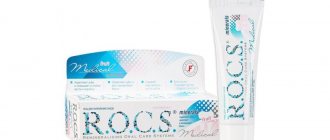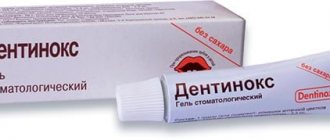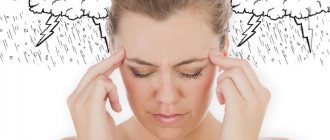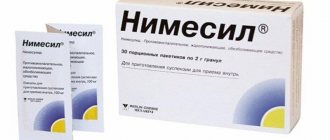Nise gel - instructions for use
INSTRUCTIONS
on the use of a medicinal product for medical use
Nise®
Registration number: P N012824/03
Trade name of the drug : Nise®
International nonproprietary name of the drug: nimesulide.
Dosage form: tablets
Compound
Each tablet contains:
Active ingredient: nimesulide 100 mg.
Excipients: calcium hydrogen phosphate, microcrystalline cellulose (type 114), corn starch, sodium carboxymethyl starch, magnesium stearate, colloidal silicon dioxide, talc.
Description
White with a yellowish tint, round biconvex tablets with a smooth surface.
Pharmacotherapeutic group: non-steroidal anti-inflammatory drug (NSAID).
ATX code: M01AX17.
Pharmacological properties
Pharmacodynamics
Non-steroidal anti-inflammatory drug (NSAID) from the sulfonanilide class. Is
a selective competitive inhibitor of cyclooxygenase-2 (COX-2), inhibits the synthesis of prostaglandins at the site of inflammation. The inhibitory effect on COX-1 is less pronounced (less likely to cause side effects associated with inhibition of prostaglandin synthesis in healthy tissues). Has anti-inflammatory, analgesic and pronounced antipyretic
action.
Pharmacokinetics
Absorption when taken orally is high (food intake reduces the rate of absorption without affecting its degree). Time to reach maximum concentration (TCmax) - 1.5-2.5 hours. Communication with plasma proteins - 95%, with erythrocytes - 2%, with lipoproteins - 1%, with acidic alpha1-glycoproteins - 1%. Changing the dose does not affect the degree of binding. The maximum concentration value (Cmax) is 3.5-6.5 mg/l. Volume of distribution – 0.19-0.35 l/kg. Penetrates into the tissues of the female genital organs, where after a single dose its concentration is about 40% of the concentration in plasma. Penetrates well into the acidic environment of the inflammation site (40%) and synovial fluid (43%). Easily penetrates histohematic barriers.
Metabolized in the liver by tissue monooxygenases. The main metabolite - 4 - hydroxynimesulide (25%), has similar pharmacological activity, but due to a decrease in the size of the molecules, it is able to quickly diffuse through the hydrophobic channel COX - 2 to the active binding site of the methyl group. 4 - hydroxynimesulide is a water-soluble compound, the elimination of which does not require glutathione and conjugation reactions of phase II metabolism (sulfation, glucuronidation, etc.).
The half-life (T1/2) of nimesulide is 1.56-4.95 hours, 4 - hydroxynimesulide - 2.89-4.78 hours.
4—Hydroxynimesulide is excreted by the kidneys (65%) and bile (35%) and undergoes enterohepatic recirculation.
In patients with renal failure (creatinine clearance 1.8-4.8 l/h or 30-80 ml/min), as well as in children and the elderly, the pharmacokinetic profile of nimesulide does not change significantly.
Indications for use
- rheumatoid arthritis;
- articular syndrome during exacerbation of gout;
- psoriatic arthritis;
- ankylosing spondylitis;
- osteochondrosis with radicular syndrome;
- osteoarthritis;
- myalgia of rheumatic and non-rheumatic origin;
- inflammation of ligaments, tendons, bursitis, including post-traumatic inflammation of soft tissues;
- pain syndrome of various origins (including in the postoperative period, with injuries, algodismenorrhea, toothache, headache, arthralgia, lumbar ischialgia).
The drug is intended for symptomatic therapy, reducing pain and inflammation at the time of use, and does not affect the progression of the disease.
Contraindications
Hypersensitivity to the active substance or auxiliary components; complete or incomplete combination of bronchial asthma, recurrent polyposis of the nose or paranasal sinuses and intolerance to acetylsalicylic acid and other NSAIDs (including a history); erosive and ulcerative changes in the mucous membrane of the stomach and duodenum (duodenum), active gastrointestinal bleeding, cerebrovascular or other bleeding; inflammatory bowel diseases (Crohn's disease, ulcerative colitis) in the acute phase; hemophilia and other bleeding disorders; decompensated heart failure; liver failure or any active liver disease; anamnestic data on the development of hepatotoxic reactions when using nimesulide preparations; concomitant use of potentially hepatotoxic substances; alcoholism, drug addiction; severe renal failure (creatinine clearance less than 30 ml/min), progressive kidney disease, confirmed hyperkalemia; period after coronary artery bypass surgery; pregnancy, lactation period; children under 12 years of age (for this dosage form, see the “Special Instructions” section).
Carefully
Coronary heart disease, cerebrovascular disease, congestive heart failure, dyslipidemia/hyperlipidemia, diabetes mellitus, peripheral arterial disease, smoking, creatinine clearance less than 60 ml/min. Anamnestic data on the development of ulcerative lesions of the gastrointestinal tract, the presence of Helicobacter pylori infection, old age, long-term use of NSAIDs, frequent alcohol consumption, severe somatic diseases, concomitant therapy with anticoagulants (for example, warfarin), antiplatelet agents (for example, acetylsalicylic acid, clopidogrel), oral glucocorticosteroids ( for example, prednisolone), selective serotonin reuptake inhibitors (for example, citalopram, fluoxetine, paroxetine, sertraline).
Directions for use and doses
The minimum effective dose should be used for the shortest possible short course. The tablets are taken with enough water, preferably after meals.
Adults and children over 12 years old - 1 tablet orally 2 times a day. If you have diseases of the gastrointestinal tract, it is advisable to take the drug at the end of a meal or after a meal. The maximum daily dose for adults is 200 mg.
Patients with chronic renal failure require a reduction in the daily dose to 100 mg.
Side effect
The frequency of side effects is classified depending on the frequency of occurrence: often (1-10%), sometimes (0.1-1%), rarely (0.01-0.1%), very rarely (less than 0.01%) , including individual messages.
Allergic reactions: rarely – hypersensitivity reactions; very rarely - anaphylactoid reactions.
From the central nervous system: infrequently – dizziness; rarely - a feeling of fear, nervousness, nightmares; very rarely - headache, drowsiness, encephalopathy (Reye's syndrome).
From the skin: infrequently – itching, rash, increased sweating; rarely: erythema, dermatitis; very rare: urticaria, angioedema, facial swelling, erythema multiforme, including Stevens-Johnson syndrome, toxic epidermal necrolysis (Lyell's syndrome).
From the urinary system: infrequently - swelling; rarely - dysuria, hematuria, urinary retention, hyperkalemia; very rarely - renal failure, oliguria, interstitial nephritis.
From the gastrointestinal tract: often – diarrhea, nausea, vomiting; infrequently – constipation, flatulence, gastritis; very rarely - abdominal pain, stomatitis, tarry stools, gastrointestinal bleeding, ulcer and/or perforation of the stomach or duodenum.
From the liver and biliary system: often - increased “liver” transaminases; very rarely - hepatitis, fulminant hepatitis, jaundice, cholestasis.
From the hematopoietic organs: rarely – anemia, eosinophilia; very rarely - thrombocytopenia, pancytopenia, purpura, prolonged bleeding time.
From the respiratory system: infrequently – shortness of breath; very rarely - exacerbation of bronchial asthma, bronchospasm.
From the senses: rarely – blurred vision.
From the cardiovascular system: infrequently – arterial hypertension; rarely – tachycardia, hemorrhages, “hot flashes”.
Other: rarely – general weakness; very rarely - hypothermia.
Overdose
Symptoms: apathy, drowsiness, nausea, vomiting. Gastrointestinal bleeding, increased blood pressure, acute renal failure, and respiratory depression may occur.
Treatment: The patient requires symptomatic treatment and supportive care. There is no specific antidote. If an overdose has occurred within the last 4 hours, it is necessary to induce vomiting, take activated carbon (60–100 g per adult), and osmotic laxatives. Forced diuresis and hemodialysis are ineffective due to the high binding of the drug to proteins.
Interaction with other drugs
The effect of medications that reduce blood clotting is enhanced when used simultaneously with nimesulide.
Nimesulide may reduce the effect of furosemide. Nimesulide may increase the possibility of side effects while taking methotrexate.
Plasma lithium levels increase when lithium and nimesulide are taken simultaneously.
Nimesulide may enhance the effect of cyclosporine on the kidneys.
Use with glucocorticosteroids and serotonin reuptake inhibitors increases the risk of gastrointestinal bleeding.
special instructions
Since Nise® is partially excreted by the kidneys, its dose should be reduced in patients with impaired renal function, depending on creatinine clearance.
Given reports of visual disturbances in patients taking other NSAIDs, treatment should be stopped immediately if any visual disturbance occurs and the patient should be examined by an ophthalmologist .
The drug can cause fluid retention in tissues, so patients with high blood pressure and cardiac problems should use Nise® with extreme caution.
Patients should undergo regular medical monitoring if they, along with nimesulide, take medications that are characterized by an effect on the gastrointestinal tract.
If signs of liver damage appear (itching, yellowing of the skin, nausea, vomiting, abdominal pain, dark urine, increased levels of liver transaminases), you should stop taking the drug and consult your doctor.
The drug should not be used simultaneously with other NSAIDs.
The drug can change the properties of platelets, but does not replace the preventive effect of acetylsalicylic acid in cardiovascular diseases .
The use of the drug may adversely affect female fertility and is not recommended for women planning pregnancy.
After 2 weeks of using the drug, monitoring of biochemical indicators of liver function is necessary.
This dosage form is contraindicated for children under 12 years of age, but if it is necessary to use nimesulide in children over 7 years of age, dispersible tablets 50 mg and suspension can be used in strict accordance with the instructions for medical use attached to them.
Since the drug can cause drowsiness, dizziness and blurred vision, care must be taken when driving vehicles and engaging in other potentially hazardous activities that require increased concentration and speed of psychomotor reactions.
Release form
Tablets, 100 mg.
10 tablets in a PVC/aluminum blister. 1, 2, 3 or 10 blisters along with instructions for use in a cardboard pack.
Storage conditions
In a place protected from light at a temperature not exceeding 25 ° C.
Keep out of the reach of children!
Best before date
3 years.
Do not use after the expiration date stated on the packaging.
Conditions for dispensing from pharmacies
On prescription.
Manufacturer
Dr. Reddy's Laboratories Ltd., India
Dr. Reddy's Laboratories Ltd., India
Names and addresses of production sites of the drug manufacturer
- Manufacturing Unit-II, Plot No. 42, 45 and 46, Bachupally Village, Kutubullapur Mandal, Ranga Reddy District, Telangana, India.
- Manufacturing Unit - 6, Khol Village, Nalagarh Road, Baddi, Solan District, HP, 173205, India.
Send information about complaints and adverse drug reactions to:
Representative office:
115035, Moscow, Ovchinnikovskaya embankment, 20, building 1
tel
Fax
Instructions for use NISE
To reduce the risk of side effects, it is necessary to use the drug in the minimum effective dose with the shortest duration of treatment. If the patient's condition does not improve, treatment should be stopped.
Use in patients with liver dysfunction
Nimesulide is metabolized in the liver to form the active metabolite 4-hydroxy-nimesulide. In patients with severe or severe liver dysfunction, the metabolism of nimesulide is impaired, clearance decreases and the concentration of nimesulide in the blood increases, which can lead to drug accumulation. There are also reports of liver dysfunction occurring while taking nimesulide, ranging from moderate to severe, including death. Thus, nimesulide is not recommended for use in patients with liver pathology. If patients taking nimesulide develop symptoms suggestive of liver damage (eg, anorexia, nausea, vomiting, abdominal pain, fatigue, dark urine) or abnormal results of liver function tests, the drug should be discontinued. Such patients are not recommended to be prescribed nimesulide in the future.
During treatment with nimesulide, it is recommended to avoid the simultaneous use of hepatotoxic drugs, analgesics, other NSAIDs and alcohol consumption.
Use in patients with gastrointestinal dysfunction
Gastrointestinal bleeding or ulcer/perforation may develop at any time while using the drug, with or without warning symptoms, with or without a history of gastrointestinal complications. If gastrointestinal bleeding or ulcers occur, the drug should be discontinued.
Nise should be prescribed with caution to patients with gastrointestinal disorders, ulcerative colitis or a history of Crohn's disease.
Use in patients with renal impairment
The drug should be prescribed with caution to patients with renal or heart failure, as its use may lead to deterioration of renal function. If renal function deteriorates, the drug should be discontinued. Patients with severe renal impairment should avoid taking nimesulide. Nimesulide should also be used with caution in patients with severe metabolic disorders, dehydration and asthenia, as these patients may be more sensitive to the renal effects of nimesulide.
Use in patients with impaired hemostasis
Since nimesulide can impair platelet function, it should be used with caution in patients with hemorrhagic diathesis, under constant monitoring.
Use in Elderly Patients
Elderly patients most often develop side effects when taking the drug, including gastrointestinal bleeding, perforation, dysfunction of the heart, kidneys and liver. Therefore, regular clinical monitoring of the patient’s condition is recommended.
Impact on the ability to drive vehicles and operate machinery
Due to the fact that, when taken orally, nimesulide can cause dizziness and drowsiness in some patients, they should refrain from engaging in potentially hazardous activities that require increased concentration.










